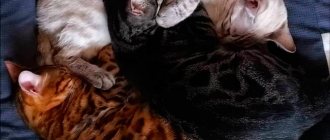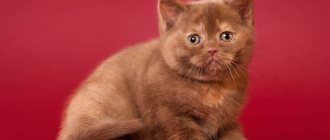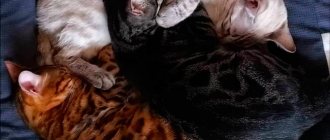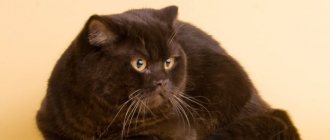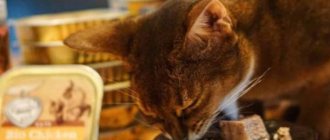The Abyssinian breed first appeared in 2001, but this species has only become popular in our time. The differences in the appearance of Abyssinian cats are quite minor. For example, some breeds have ticking (when the coat is covered with a smooth transition from one shade to another), while others do not have any patterns on their coat at all.
If you look closely at these pets, each fiber is painted in two colors, which alternate with each other.
It is precisely because of its fur that the Abyssinian cat differs from other breeds; they have it:
- shiny;
- smooth;
- short;
- without drawings;
- ticking.
These kittens have an undercoat that is very bright and rich. The only thing that an Abyssinian can have on its body is a white chin (see all photos of the Abyssinian cat).
Experts have officially recognized only four types of color of these kittens - these are:
- faun;
- sorel (red);
- blue;
- wild.
So let's discuss all these colors together.
WCF standard
The body
is muscular, of medium size, strong, flexible, dense, of medium length.
Tail
rather long, pointed, thick at the base.
Limbs
sinewy, long and slender. The paws are narrow and oval.
Head
wedge-shaped, medium proportions, soft contour, a slight notch at the transition to the muzzle is desirable. When viewed from the front, the muzzle is rounded and fits into a parabola, pointing downwards. Strong chin, medium length nose. The profile is without a stop, but not straight either, the forehead is slightly convex. Graceful neck.
Ears
large, widely and vertically set and wide at the base. The tips are rounded, with a “thumb print”, tassels on the ears are desirable.
Eyes
large, shiny, expressive, almond-shaped. Wide apart, slightly oblique (the outer corners of the eyes are higher than the inner ones). Color - pure, clear, juicy amber yellow or green, with eyelid rims.
Wool
short, thin and tight-fitting. Double or triple ticking. Dark ends of hair are preferred.
Flaws:
White spots, white medallion, too much white on the chest, closed necklaces, gray or too light undercoat, too little ticking, moire stripes. Pattern/stripes on the face or limbs. In dark colors there is no dark tip of the tail, dark “soles” on the hind legs, or dark rims on the eyelids.
Siamese type, round head, small or pointed ears, round eyes, mixed eye color, too noticeable feet.
| Body: 20 points Head, ears: 15 points Eyes: 10 points Color: 25 points Ticking: 15 points Texture: 10 points Condition: 5 points |
Colors:
Wild color, sorrel, blue, beige fawn, tortoiseshell, tortoiseshell sorrel, blue tortoiseshell, tortoiseshell fawn, black silver, sorrel silver, blue silver, fawn silver, blue tortoiseshell silver, tortoiseshell fawn silver
Origin of the breed
The Abyssinian breed is one of the oldest. Its exact origin is unknown. A popular version says that these are descendants of African aboriginal cats.
The first known representative of the breed was named Zula. It belonged to the wife of the British military captain Barrett-Lenard. According to the official version, the couple brought the animal from Ethiopia, formerly Abyssinia, in 1868 after the end of the Anglo-Abyssinian War.
The intrigue is that in Ethiopia the characteristic ticked color is not found in domestic cats. In this regard, felinologists have put forward several theories:
- The breed was bred in England, and the color is the result of a random mutation. Many people disagree with this version - Abyssinians do not look like native English cats, foreign blood is clearly present in them.
- Zula was brought from Afghanistan or Southeast Asia. In those years, England fought many colonial wars, and there may well have been a mistake regarding the origin of the cat.
- Zula was not a domestic animal, but a tamed wild animal. According to different versions, she could belong to the steppe, reed, dune or golden cats.
- Zula's homeland was Egypt. Supporters of this version note that images of cats on the tombs of the pharaohs, as well as cat figurines created in Ancient Egypt, resemble Abyssinians both in body proportions and colors.
The Abyssinian cat was first presented at the Crystal Palace Cat Show, held near London in 1871, and was awarded third place. According to an article in Harper's Weekly magazine, it was Zula.
The further fate of the ancestor of the breed is unknown, but, obviously, she gave birth to offspring. It is believed that Abyssinians originally crossed with British Shorthair cats.
Some researchers are sure that the ancestor of the breed was a wild cat
Subsequently, the history of the breed developed as follows:
- In 1889, Harrison Weir, the famous feline researcher, published the first breed standard in the book All About Cats.
- In 1896, the breed was registered in the stud book of the National Cat Club.
- In 1907, two Abyssinians were sent to the USA. In 1917, the breed was recognized by the CFA.
- Gradually, the Abyssinians won fans in other countries: they appeared in France in 1927;
- in Holland - 1937;
- in Denmark - in 1950;
- in Sweden - in 1953;
- in New Zealand - in 1955;
- in Australia - in 1959
The regal beauty of the Abyssinians has won fans in many countries around the world.
At the moment, the breed is recognized by all world felinological clubs.
n 25 WILD COLOR (RUDDY)
Color:
Body color is warm brown with black ticking.
The base of the hairs is dark orange, the belly and inner sides of the limbs are also dark orange or dark apricot, in accordance with the base of the hair on the rest of the body. The darker shade along the back forms a “wild” line. The tip of the tail and the "soles" of the hind legs from the pads of the feet to the hock joint should be rich black. Nose:
brick red with black edging.
Paw pads:
black.
Health
Abyssinian cats are generally quite healthy. With proper care and good heredity, an animal can live 12–15, and sometimes 20 years.
However, they are susceptible to a number of diseases. Among the most common in the breed:
- pyruvate kinase deficiency;
- progressive retinal atrophy;
- kidney amyloidosis;
- gingivitis;
- depression.
Pyruvate kinase deficiency
Pyruvate kinase deficiency is a hereditary disease that automatically leads to anemia. Her symptoms:
- weakness;
- decreased appetite;
- weight loss;
- deterioration in wool quality;
- pallor and sometimes yellowness of the mucous membranes of the mouth.
Symptoms of anemia may disappear from time to time without outside intervention, then appear again. Exacerbation is provoked by pregnancy, infections, and certain medications. The disease also progresses in older animals.
A DNA test helps identify the problem.
Effective conservative treatment has not yet been developed. To maintain strength, your veterinarian may prescribe folic acid and red blood cell replacement therapy. Sometimes splenectomy is used, that is, removal of part of the spleen.
Progressive retinal atrophy
Progressive retinal atrophy is a hereditary disease that causes degeneration of the retina of the eye, gradually leading to blindness. Initially, it manifests itself as the animal's growing awkwardness due to deteriorating vision. As the disease progresses, the pupils dilate and light begins to reflect from the back of the eye. Sometimes the lens becomes cloudy.
For diagnosis, an ophthalmological examination and sometimes electroretinography are performed.
There is no cure. However, most cats quickly come to terms with blindness and navigate the apartment by smells and memory. Problems can arise for them only due to rearranging the furniture.
Renal amyloidosis
Amyloidosis is a metabolic disorder that causes pathogenic amyloid protein to accumulate in the kidneys and other organs. It is believed that the disease is hereditary or develops due to infections, inflammation or severe poisoning. Usually young animals or mature animals over seven years of age are affected. Abyssinians account for 97% of cases of this disease among cats.
The symptoms are:
- exhaustion;
- increased thirst;
- frequent urination;
- sometimes vomiting;
- digestive disorders;
- pallor of the mucous membranes.
Vascular thrombosis, abdominal dropsy, and swelling of the muzzle and extremities may develop.
Diagnosis includes blood and urine tests, sometimes x-rays and a kidney biopsy.
A complete cure is currently impossible, but if the disease is detected at an early stage, the right diet and symptomatic therapy can prolong the animal’s life for a long time.
Gingivitis
Gingivitis is inflammation of the gums. Without treatment, it spreads to the ligaments and bones of the jaw. The tooth begins to become loose and falls out after a while. In advanced cases, inflammation affects internal organs, including the liver and kidneys.
The disease develops due to tartar. Shows itself:
- severe salivation;
- bad breath;
- red, swollen and bleeding gums.
The diagnosis is made based on visual examination. In some cases, a biopsy is needed.
Treatment depends on the stage:
- in the early stages, you can get by with removing tartar and regular teeth cleaning;
- in the later stages, medicinal ointments, antibiotics, immunomodulators and anti-inflammatory drugs will be needed.
Regular tooth brushing is important to prevent gingivitis
Depression
Depression in Abyssinians occurs due to lack of attention. It is expressed by baldness in the area of the back and hips, and the cat can pull out its own hair. Constant skin irritation leads to ulcers and dermatitis.
In addition to symptomatic treatment, it is necessary to eliminate the cause of the disease: the animal should be given more attention, and if this is not possible, make a friend for it.
b 25 SORREL (RED)
Color:
The body color is a brilliant copper-red with red-brown ticking. The base of the hairs is dark apricot, the belly and inner sides of the limbs are also dark apricot, in accordance with the base of the hair on the rest of the body. The darker shade along the back forms a “wild” line. The tip of the tail and the “soles” of the hind legs should be red-brown.
Nose:
Pink with red-brown edging
Paw pads:
Pink
Owner reviews
Brother and sister are as different as the sun and the moon. Eric is a big neat guy, he is hair to hair, Flora is always licking his fur in different directions. Eric is afraid of everything new and noisy, Flo runs headlong towards the commotion. Eric obeys and is afraid when I scold him, and gray hair is like water off a duck's back. But they are both very mobile and active, both sit on their hands a little, and are very smart.
irainmost
https://irecommend.ru/content/moi-khorek-enot-nu-tochno-ne-koshka-lyubimaya-flora-velikolepnyi-erik-i-vse-chto-v-nuzhno
This is the cat who greets you when you come home, who follows you everywhere, he shows interest in everything you do. He runs after his brother like a tail, starting with brushing his teeth in the morning and falling asleep on his lap in the evening. I have only seen this in dogs! But what won me over was the fact that he carries his toy mice. He brings the larger one to his bowl for “feeding”, and he bathes the smaller ones in his glass of water - throws them in and pulls them out with his paws.
demenoid
https://otzovik.com/review_150400.html
ns 25 BLACK SILVER
Color:
The base of the coat is pure white with black ticking.
A slightly darker shade along the back forms a line, it should appear especially dark. The tip of the tail and the "soles" of the hind legs from the pads of the feet to the hock joint should be rich black. Nose:
Brick red with black edging
Paw pads:
Black or brownish-black
Eye color:
Green or bluish-green, green preferred, with black edging.
Where can I find information about the cat?
I advise you to find out about your future Abyssinian cat on the website of the felinologist breeder. There you can find out the address and contacts of the nursery.
The owner of the cattery will take a photo of the kitten, describe the color and character, and tell about the pedigree. He will also share a video review of his cat farm and the living conditions of his grandparents and invite you to meet the kittens.
This information will help you avoid future troubles in your pet's behavior. After all, the environment of the parental home affects the character and socialization of the maturing animal.
Useful stuff:
website building.
In just three lessons, you can create your own website about cats or dogs for your cattery and for additional income for free. Find out more>>>
bs 25 SORREL SILVER
Color:
The base of the coat is pure white with red-brown ticking.
A slightly darker shade along the back forms a line, it should appear especially dark. The tip of the tail and the "soles" of the hind legs from the pads of the feet to the hock joint should be a rich red-brown. Nose:
Brick red with brown edging
Paw pads:
Cinnamon or chocolate
Eye color:
Green or bluish-green, green preferred, with brown edging.
Advantages and disadvantages
Experts highlight the following advantages of the breed:
- sophistication in every movement;
- smart;
- active and inquisitive;
- friendly with children and other animals;
- rare coat color, different from its relatives.
The disadvantages of Abyssinians include:
- naturally cautious;
- do not like to sit on the owner’s lap, preferring elevated places in the apartment;
- love to play mischief;
- They cannot be without their owner for a long time.
as 25 BLUE SILVER
Color:
The base of the coat is pure white with steel blue ticking.
A slightly darker shade along the back forms a line, it should appear especially dark. The tip of the tail and the "soles" of the hind legs from the pads of the feet to the hock joint should be a rich steel blue color. Nose:
Brick red with blue edging
Paw pads:
Bluish-gray
Eye color:
Green or bluish-green, green preferred, with black edging.
Food prohibitions
In addition to healthy foods, there are also those that are strictly not recommended to be included in food:
- Chicken and fish bones, since cats cannot chew them, and the bone can injure both the gum and tooth.
- Raw meat - duck, goose, pork. Fatty lamb is also contraindicated.
- Smoked meats in any form, as well as seasonings, spices and salt.
- Marinades and fried foods.
- All legumes are excluded from vegetables: peas, soybeans, beans, and potatoes.
Read about what cats and kittens should not eat.
Uncontrolled use of the above products affects the pet's immunity and the appearance of its coat - it becomes dull and dandruff may appear. Legumes can cause gas and stomach upset.
If the cat receives only natural food, then it is necessary to additionally introduce vitamins and supplements, since ordinary products do not contain the full range of necessary substances.
Also read the article about whether cats can be fed raw foods.
cs 25 FAWN SILVER
Color:
The base of the coat is pure white with warm cream ticking.
A slightly darker shade along the back forms a line, it should appear especially dark. The tip of the tail and the “soles” of the hind legs from the pads of the feet to the hock joint should be a rich, warm cream color. Nose:
Pink with dark pink edging
Paw pads:
Dark pink
Eye color:
Green or bluish-green, green preferred, with black edging.
Note: Any shade of cream or brown in the undercoat is a fault on all silver varieties.
Character
Abyssinian cats exhibit a fairly lively as well as intelligent temperament. The main traits of their character are curiosity and quick learning, thanks to which animals almost immediately learn the rules of behavior in the house.
Abyssinian cats are also characterized by a certain amount of restlessness.
Pets of this breed are great for families with children. After all, despite constantly demonstrating their independence, they are quite sociable and playful.
Abyssinian cats can stand up for themselves when required.
In addition, cats are neat, love to show care and attention, and are stress-resistant, but they can start to growl and hiss if they get very scared. And because animals love to eat well, they can sometimes attack domestic dogs or other pets.
CFA Standard
GENERAL CHARACTERISTICS:
The general impression of the ideal Abyssinian is an elegant medium-sized cat with an original color and royal dignity. The Abyssinian is flexible, strong, muscular, energetic and inquisitive in all conditions. This is a well-balanced cat both physically and emotionally.
HEAD:
A modified wedge with rounded outlines - all lines and planes have smooth transitions and contours. The transition from the forehead to the nose is pronounced, the forehead is full, wide between the ears and smoothly blending into the neck.
MUZZLE:
rounded, without pinch. The chin is wide and should not be slanted or protruding. Adult cats have more developed jaws.
EARS:
alert, large, moderately broadly directed, broad and cupped at the base, open. The hair on the ears is short and fine, with clear, contrasting ticking.
EYES:
almond-shaped, large, shiny and expressive. Neither rounded nor slanted. The eyes are outlined with a dark line surrounded by a light tone.
BODY:
medium length, flexible and graceful, the muscles are well defined, but not prominent or coarse. The body structure is between compact and elongated. Proportion and balance are more important than size.
LEGS and FEET:
proportional, graceful, the Abyssinian seems to stand on his toes. The paws are compact, small in size and oval in shape. Toes: five in front and four in back.
TAIL:
thick at the base, gradually tapering towards the tip.
WOOL:
soft, silky, original texture - dense and elastic to the touch, shiny. Medium length, close to the body. Hairs with zonal coloring - two or three colored rings alternating with a lighter tone.
FLAWS:
elongated or narrow head. Dark colored rings on the legs, open necklaces on the chest and stripes on the tail. Cool or gray shades in color. White undercoat in blue and fawn colors.
DISQUALIFICATION:
white medallion, or white anywhere except the chin and eye rims, tail defects, closed necklace on the chest, gray tone at the base of the hair throughout the body, any black hairs on the red coat, incorrect number of toes. Unrecognized color.
Abyssinian color:
The coat color is warm and luminous. The original color is formed by hairs with contrasting stripes, bright even at the base of the hair. The base color is bright and clear, a deeper tone is desirable, a darker stripe along the ridge is allowed unless it is very contrasting. Preference is given to animals without patterns on the lower part of the body, legs and tail. On the muzzle there are dark lines around the eyes and eyebrows, on the cheekbones, shading and dots on the underarms. The eyes are outlined with a dark line, surrounded by light glasses. Eye color - gold or green, monotony and depth of color are encouraged.
Wild color:
black on red-brown tone.
Red:
chocolate on a red background.
Blue:
blue on a beige tone.
Fawn:
cocoa color on a light beige tone.
Silver
- all of the above color variations on a silver tone (not recognized).
All colors: Nose
- pink with a liner in the color of the main color;
Paw pads
- dark in the color of the main color.
| Head (25) Muzzle………. 6 Head……….. 6 Ears………… 7 Eye shape……. 6 | Body (30) Body………. 15 Legs and paws .. 10 Tail ……….. 5 | Wool (10) Texture…….. 10 | Color (35) Color……….. 15 Ticking…….. 15 Eye color….. 5 |
What determines the color of the Abyssinian
The unusual and original colors of the Abyssinians are their calling card. This is due to the presence of several genes in their genotype, the dominance of which determines coat color.
Genes responsible for coat color
The following genes are responsible for the coat color of Abyssinians:
- Agouti "Ta" gene. It determines the presence of ticked hairs on the fur;
- "Ttb" gene. With its dominance, kittens are born of a “tiger” color;
- “U” gene. When it is dominant, there is no clear pattern on the coat.
The color of a purebred kitten largely depends on the combination of genes planned by the breeders. Kittens may be born with patterns on their fur that will disappear on their own as they grow older.
Attention: the presence of a gray and faded undercoat on a kitten indicates a crossbreed.
Despite the fact that the presence of white spots on the face, belly, paws and tail is not considered a defect, they try not to use such cats for breeding.
Genes responsible for color tone
Looking at the colors of an Abyssinian cat, you can see that they are formed not only due to their own color, but also due to the tone of this color. That is, the dominant gene in them is the D gene, and its recessive companion is d. Together these genes give a rich dark or lightened color. The dominance of genes is manifested due to their combination:
- a combination of DD or Dd genes produces dark tones;
- the combination of recessive genes dd is responsible for the light color.
In other words, the Abyssinian wild color is obtained through a combination of black color and rich tone. That is, a pair of DD or Dd genes. The Abyssinian blue color is obtained due to the combination of black and light tones, namely the dd genes.
Colors according to TICA standard
Ruddy:
Orange-brown, covered with two or three stripes of black or dark brown. The upper lip is darker, with orange-brown skin. The outer part of the body is covered with shorter hair and should have at least one ticking stripe. Dark shading along the spine is allowed if it is fully ticked. The inside of the body, chest, inside of the legs should be red-brown without ticking, medallions or spots. Color variations range from apricot to deeper, with deeper flowers being preferred. The tail should be black with no rings or gray spots. Paw pads are black or dark brown with black between the toes. Eye color - gold, green, copper or gazelle. Richer and deeper tones are preferred. The nose is brick red.
Sorrel (Cinnamon):
The appearance is orange-brown with red ticking and chocolate brown. The tail is chocolate brown. Deeper sorrel (cinnamon) colors and richer ticking are preferred. The paw pads are pink with brown between the toes. Eye color - gold, green, copper or gazelle. Richer and deeper tones are preferred. The nose is pink.
Blue
A warm, soft raw blue with darker blue ticking. The base hair, lower body, chest, inner legs are cream. The spine is a darker shade than the body color. The tail is a darker shade of blue. Good full ticking is preferred. The paw pads are lilac-blue with blue between the toes. Eye color - gold, green, copper or gazelle. Richer and deeper tones are preferred. The nose is dark pink.
Fawn
A warm pink-beige with a powdery effect, ticked into a deeper, darker pink-beige. Base hair, lower body, chest, inner legs are fawn. The spine is a darker shade than the body color. The tail is a darker shade of pink-beige. Good full ticking is preferred. The paw pads are lilac-pink with pink-beige between the toes. Eye color - gold, green, copper or gazelle. Richer and deeper tones are preferred. The nose is lilac-pink.
Rare colors
Although the Association of Cat Fanciers recognizes only four colors of Abyssinians, representatives of the breed can have other colors that are no less beautiful and multi-dimensional.
Silver
Ancient chronicles indicate that “silver” is the earliest color of the Abyssinian cat. But since high-quality photographic equipment did not yet exist centuries ago, it is difficult to judge what the suit was. This is the main reason why the Association does not include it among the standard Abyssinian breeds.
Modern silver Abyssinians are characterized by a ticked coat with a transition from silver-gray to black. At the base the hair is practically unpigmented, gray with a shiny steel tint. It darkens to black towards the tip. The transition does not look contrasting - light gray, beige, dark cream and cinnamon ranges are visible on the hair.
The paws of silver cats are colored evenly, monochromatically – black. The color of the nose varies from dark pink to salty red depending on the richness of the color.
Often silver Abyssinians are born with defects - spots, stripes on the fur. Finding an animal of the perfect silver color is a rarity these days. The additional color is graded depending on the predominant colors in the ticking:
- "Blue Silver" The base is white and gray. The tip of the hair is blue-gray. This gives the effect of a silver-blue coating on the fur coat.
- "Fawn Silver". The base of the hair is silvery and white. The tip is dark beige, dark fawn. Spray tone – soft yellowish-gray, yellowish-blue.
- "Sorrel silver". The coat is silvery at the base, then turns into a cool chocolate color. The tone of the spray on the fur coat is peach with a silver tint.
Abyssinians "silver":
Chocolate
Despite its lack of recognition, it is one of the most common colors of Abyssinians. In such animals, the base of the hairs is copper and golden. Then - an apricot transition to a rich dark chocolate tone. All paws are a single cocoa color. The visual effect is a fur coat of a bright copper shade with chocolate coating.
Chocolate color:
NBC colors. Review
Silver cats only have an undercoat that differs from tabby cats, with four ticking colors that are the same for both species. In all silver variations, the preferred undercoat color is white. The ticking matches the color of the coat and gives the overall appearance of a silver color. An ivory undercoat is also acceptable. Yellow or brown spots on the chest, belly, or inside of the legs are not desirable, although they are not considered a fault.
Silver: The ticking or dark stripes on the coat are black. The undercoat is white and silver. The tail is completely cinnamon color without rings. Eye and pad color: same as Ruddy. The nose is pink.
Silver-Cinnamon The ticking or dark stripes on the coat are the color of cinnamon. The undercoat is white and silver. The tail is completely black without rings. The color of the eyes and pads, as well as the nose: the same as Sorrel.
Blue-Silver: The ticking or dark stripes on the coat are blue-gray. The undercoat is white and silver. The tip of the nose and the color of the spine are like Blue. The color of the eyes and pads, as well as the nose: the same as Blue.
Fawn Silver: The ticking or dark stripes on the coat are fawn colors (pink beige).
The undercoat is white and silver. The tip of the nose and the color of the spine are like Fawn's. The color of the eyes and pads, as well as the nose: the same as Fawn. Abyssinian cat standards https://abyssin.net/wp-content/uploads/2016/03/cat10.jpg https://abyssin.net/wp-content/uploads/2016/03/cat10.jpg2018-10-08T22:35 :47+03:00 abyssinAbout the Abyssinian breed articlesWCF standard The body is muscular, medium size, strong, flexible, dense, of medium length. The tail is quite long, pointed, thick at the base. The limbs are sinewy, long and slender. The paws are narrow and oval. The head is wedge-shaped, of medium proportions, soft contour, a slight notch at the transition to the muzzle is desirable. When viewed from the front, the muzzle is rounded and fits into a parabola, pointing downwards. Strong...abyssinPhilip Sirotin [email protected] Cattery
Abyssinian cat fur care
Abyssinian cats are ideal for indoor keeping. They have good health, practically do not shed (thanks to their short hair), are completely unpretentious in food, and do not cause any trouble to their owners.
But they, like any other purebred cats, need to be provided with proper coat care:
- Once or twice a week, your pet must be combed with a special comb with metal teeth;
- During the spring molting period, it is recommended to periodically bathe cats and brush them frequently;
- For bathing Abyssinians of all colors, a special shampoo is used, and the water is changed 2-3 times during the bathing process. This breed loves to swim, but hates showering.
In order for your pet to have perfect fur, it needs to have a proper diet, be given the opportunity to exercise a lot and keep it clean.
In conclusion, it is worth noting that Abyssinian cats are distinguished by: their regal coloring, the arrogant look of their huge expressive eyes, and their nobility. They conquer their owners with obedience, friendliness, affection and warmth. This breed is characterized by loyalty and affection for its owners, and does not tolerate loneliness at all. Therefore, if you are often not at home, it is recommended to get two cats at once, and not necessarily of the same breed. Instead of a cat, you can get any other pet (just not a parrot or rodents), since Abyssinians get along well with all animals and always try to find contact with them.


